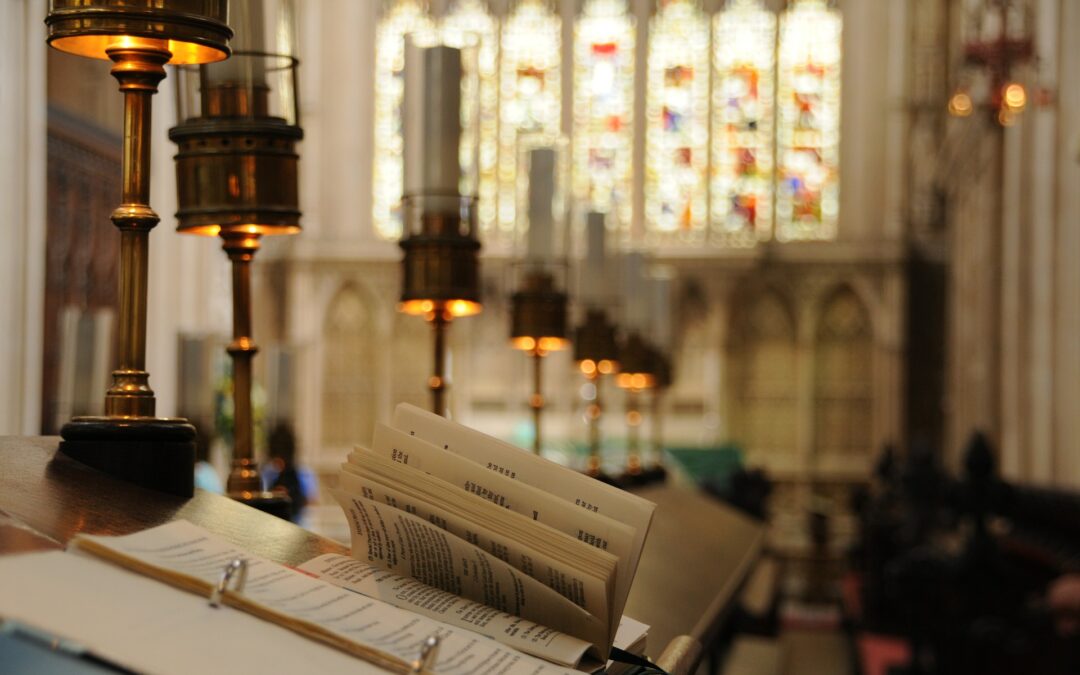O God, whom saints and angels delight to worship in heaven: Be ever present with your servants on earth who seek through art and music to perfect the praises of your people. Grant them even now true glimpses of your beauty, and make them worthy at length to behold it unveiled for evermore; through Jesus Christ our Lord. Amen.
–Book of Common Prayer, 650
Having often argued for what sort of devotion to the saints is not permitted to Anglicans — praying to them in public liturgies — it is worth asserting what sort of devotion is permitted. Our Church architecture and furnishings give us a guiding paradigm. Whereas I have seen with my own eyes a Roman Catholic Church with a 25 foot painting of Mary “Queen of Souls” behind the altar; in Anglican Churches the representation of the saints is usually much more modest: confined to the stained glass windows along the side-walls of the church, or perhaps at most some small, non-centered statues in a reredos. This is mete and right. The saints are like us, members of the body, adoring our head, the universal Savior, the only mediator between God and man, Jesus Christ. Right devotion to the saints therefore is characterized by imitation. God has actually charged us with this task, as it says in Philippians 3:17: “Brothers, join in imitating me, and keep your eyes on those who walk according to the example you have in us.” We are to know and study the lives of those Christians who came before us who were radically devoted to their Lord and ours.
But how can we do this, if we don’t know much about them? Reading ‘Lives of the Saints’ is certainly an edifying past-time to those who have the leisure so to do, but a more instantly accesible “snapshot” of the commemorations in our Kalendar would be an excellent resource. A book styled on ‘Lesser Feasts and Fasts’ is currently being worked on (working title ‘Sanctifying Time’) by the Rev. Arnie Klukas, but no publication date has yet been set. But there remains an even more nimble catechetical tool that is wanting development: hymnody.
The 1982 Hymnal has given us a structure by which we can easily create such a resource: Hymn #231/232, “By all your saints still striving,” set to the familiar tunes of King’s Lynn, and Nyland. This hymn has a unique structure: the first stanza praises Jesus for working so profoundly in his saints, the middle stanza is “plugged-in” from the list of stanzas (written by Horatio Nelson at the end of the 19th century) on the opposite page, commemorating the saint whose feast day it is, and the final stanza praises God as Trinity in Unity. It’s a hymn with perfect Anglican proportions: A passing middle stanza that references the highlights of a particular saint’s life, sandwiched between direct adoration of the Living God. Like the saints in stained glass: Present, but not front and center. Stanzas are already supplied for most of the “Red-letter” days in the BCP tradition, but what about the other 70 or so “black letter” commemorations that occur in the 1662 BCP or the 110 “optional” commemorations that occur in the 2019 BCP?
If we could have a “middle stanza” to be inserted into Hymn 231/232 for each of these lesser commemorations, it would be a rich and easy way of honoring the Saints as God intended them to be remembered, and would be a source of joy to include in the keeping of the commemoration amidst the Daily Office or Holy Communion.
I have attempted a couple myself. Here are some examples:
Justin Martyr (June 1)
We praise you Lord, for Justin,
Martyr-Apologist
Discerning revelation
In Plato and the rest
For Jesus is the telos
Of true philosophy,
But ‘gainst the Empire’s idols:
Resistant ever be!
John Calvin (May 27)
We praise you Lord for Calvin,
A lawyer by his trade
Who organized good doctrine
That Christian minds be stayed.
He recognized your sov’reignty
In all that came to be,
Reform our hearts anew, Lord
With Law’s good uses three.
James DeKoven (Mar 27)
For James Dekoven praise you,
Almighty God and Lord,
Confessor to the broken,
And teacher of your Word.
Iron encased in Velvet,
Gentle and yet resolved;
The mitre was denied him but
His labors’ worth is proved.
I am, as you see, but an amateur; but it is a great deal of fun trying to make these, and weave in as many little biographical highlights as you can in such a tiny space. This is where you, dear reader, come in. Whereas this would be a herculean undertaking for one author, since a knowledge of each saint’s life is required, as well as the time and ability to sculpt an eight-line God-honoring, catechetical-biography—this project could be crowd-sourced! So, to all you with a musical, poetic ear, here is the Google Doc; have at it! (It helps to get Nyland firmly stuck in your head first.)
If you would like to submit a stanza — please do so! If you would like to propose a better line to an already existing one, feel free! If you would like to propose an entirely new stanza to replace one already there — paste it alongside (shift+ctrl+v pastes with host formatting), and other editors can comment on their favorite. If you make an edit to the file, please add your name to the list of contributors at the very bottom of the document.
Let the collaboration begin! – And may the glory of Christ in His saints be sung in our Churches!

The Rev. Ben Jefferies
Fr. Ben Jefferies s a sinner, grateful to the Lord for his mercy. He grew up in England and emigrated to the United States in 1999. He went to Wheaton College, and several years later discerned a call to ministry and attended seminary at Nashotah House. He was ordained to the priesthood by Archbishop Duncan in 2014. He currently serves The Good Shepherd Anglican Church in Opelika, Alabama. He served on the Liturgy Task Force of the ACNA from 2015-2019, and was the lead designer for the production of the printed Prayer Book. He continues as the Assistant to the Custodian of the Book of Common Prayer (2019), and serves on the board of directors of Anglican House Media Ministries. He is married with three daughters.

